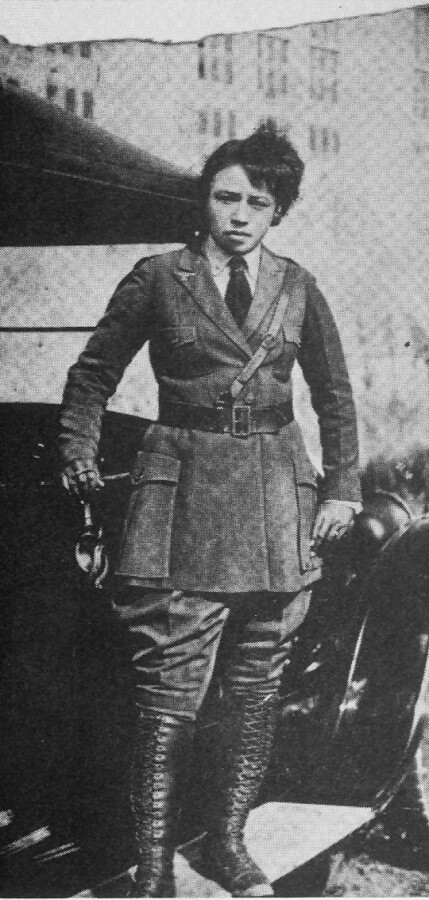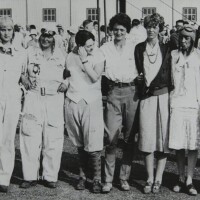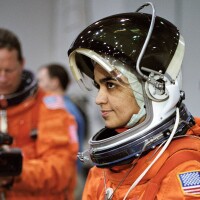Meet the Daring Women of Color Who Beat Bigotry in Aviation


Relive the excitement of man’s first steps on the moon and the long journey it took to get there with 20 new hours of out of this world programming on KCET's “Summer of Space" Watch out for “American Experience: Chasing the Moon” and a KCET-exclusive first look at "Blue Sky Metropolis," four one-hour episodes that examine Southern California’s role in the history of aviation and aerospace.
“No one had ever heard of a black woman pilot in 1919. I refused to take no for an answer.”- Elizabeth “Bessie” Coleman
Bessie Coleman had the odds stacked against her since she was born. Nicknamed “Queen Bess,” Coleman was the first woman of African and Native American descent to hold a pilot license. It was far from easy.
Born on January 16, 1892, nearly ten years before Orville Wright powered the first aircraft 20 feet above a windy beach in Kitty Hawk, North Carolina, Coleman was raised in a family of sharecroppers in Atlanta, Texas. One of 13 children, Coleman was an avid reader. The colorful Wonderful Wizard of Oz and his flying balloon inspired her to finish high school and attend college.
At 23-years-old, Coleman moved to Chicago, where she lived with her brothers and worked as a manicurist. During the day, she read and listened to the incredible stories of flight from black pilots returning home from the Great War. She was hooked, determined to become a pilot.
Like many aspiring aviators, Coleman developed an early interest in flying but was turned away from every U.S. flight training school she approached, as they refused to admit people of color. Her half Cherokee background, inherited from her father, didn’t help much either.
Coleman would forge her own path with a little push from editor and publisher Robert S. Abbott, founder of the Chicago Defender and one of the first African American millionaires. Abbott encouraged her to study abroad where she was graciously welcomed. Taking his advice, Coleman learned French at a language school in Chicago before traveling to France for flying lessons.
It would take a trip across the Atlantic for her to become one of the first black female pilots. She was accepted into the famous French flight school run by plane designers Gaston and René Caudron: the École d’aviation du Crotoy.


Coleman walked to the flight school every day. In the air, she mastered tailspins, banking and looping the loop. After seven months of training, on June 15, 1921, Coleman became the first woman of African American and Native American descent to earn a pilot's license from the Caudron Brothers’ School of Aviation. To receive this license, she demonstrated her skills with challenging life-saving maneuvers, including turning off the engine before touching down.

The spirited woman from Texas practiced in a Nieuport 82 biplane primarily built for racing. Coleman biographer Doris L. Rich described the plane as having “a steering system that consisted of a vertical stick the thickness of a baseball bat in front of the pilot and a rudder bar under the pilot's feet.” During one of her practice flights, Coleman witnessed the death of a fellow student in a plane crash. Although shaken, she persisted and spent the next two months taking more lessons and polishing her skills.
Barnstorming, essentially providing aerial entertainment, was the ideal way to make a living for female flyers of the era. With no one willing to teach her how to perform stunts in the U.S., Coleman soon returned to France to complete advanced courses. A little later, she traveled to Germany to visit the Fokker Corporation, where she was taught by Anthony Fokker, one of the world’s most distinguished aircraft designers. Back in America, she became a successful air show pilot flying in Curtiss JN-4 biplanes and other army surplus aircraft left over from the war. Known for performing flying tricks, “Queen Bess,” was incredibly popular for the next five years.
Sadly, her flying career proved to be short-lived. Coleman purchased a Curtiss JN-4 but was unaware it had been poorly maintained. Ten minutes into her first flight on April 30, 1926, the plane unexpectedly went into a dive, spinning 3,000 feet above the ground in Jacksonville, Florida. Coleman was thrown from the plane, dying instantly. It happened one year before Charles Lindbergh made his historic transatlantic flight in the Spirit of St. Louis.
Coleman blazed a trail for future aviators of color who were left out because of their race.
There was Willa Brown from Kentucky, the first African American woman to run for the United States Congress and the first African American officer in the U.S. Civil Air Patrol. Together with her husband Cornelius Coffey — an experienced aviator in his own right — and Enoch Waters, she founded the Cornelius Coffey School of Aeronautics in 1939. They were pivotal in organizing the Tuskegee Airmen program during World War II and trained hundreds of pilots, several of whom would go on to become Tuskegee Airmen.
After learning African Americans weren’t allowed to take off in airports with white customers, aviator Janet Harmon Bragg and a group of black classmates bought land to build their own air club and runway. In 1928, Bragg became the first black woman to enroll in the Curtiss Wright School of Aeronautics in Chicago.
Other firsts followed. Katherine Sui Fun Cheung was the first woman of Chinese ancestry to earn a pilot’s license in the U.S.
Born in 1904 China, Cheung came to Los Angeles in 1931 to join her father and study at the Los Angeles Conservatory of Music. Her love of flying would take precedence over her piano skills when a cousin invited her for a ride in the sky. Cheung soon began competing in air races and performing aerobatics in air shows. In 1935, Cheung joined the Ninety-Nines organization for women pilots, an association founded by her friend Amelia Earhart. After the loss of Earhart’s disappearance over the Pacific Ocean and after Cheung’s cousin died while testing his plane, Cheung returned to China to open a flying school and became a flight instructor in the U.S. after World War II.
Bessie Coleman and Katherine Cheung were unwavering trailblazers. Strong-willed and steadfast, they were smart, determined women who would not take no for an answer. Defying racial and gender bias, they set the mark for future female flyers during the early years of aviation.

Top Image: Bessie Coleman, shown here on the wheel of a Curtiss JN-4 “Jennie” in her custom-designed flying suit (circa 1924). | Smithsonian Institution


